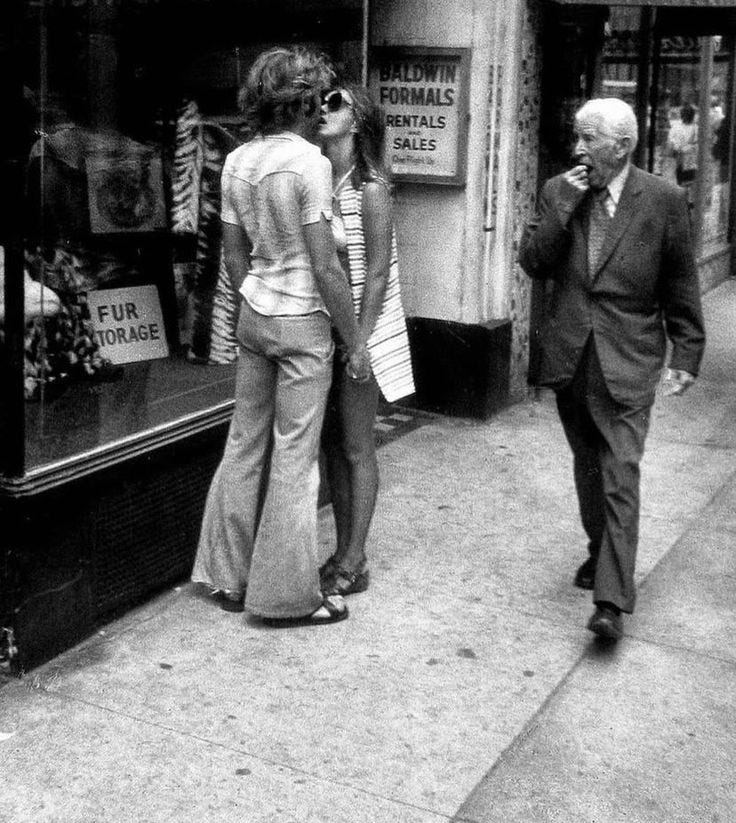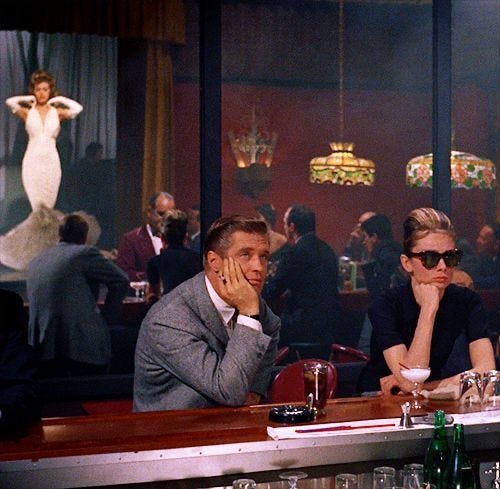I wish more people came up to me on the street. In bookstores. In the messiness of daily life. A couple weeks ago, I was walking to pick up an order from a neighborhood joint when I clocked a man walking by—he stared for that extra second. I noticed him because he was sharp. Well-dressed. A clean suit and a certain presence. Wall Street has its occasional eye candy. I picked up my food and started heading home, when I saw him again—this time standing still on the corner. Seconds later, he was walking beside me, asking about my dog, my work, and whether I might want to grab a drink sometime.
I called my best friend right after. Her reaction? “Uhh, that’s creepy.”
And of course, there’s truth in that. The idea of someone waiting for you and walking you home is a concerning approach in most contexts. If he hadn’t seemed grounded and decent, I’d have felt uneasy too. But instead, I found it… kind of endearing. And maybe that’s because it just never happens. I don’t get approached. Not in bookstores, not on the street, not in bars—not even when I’ve put on my most alter-ego inducing perfume, a feel-good outfit, and the universe feels just right. So I’m making a case for this kind of approach. In daylight, in public. In a way that’s respectful and human because I find it admirable—rare, even—to gather up the nerve to walk up to someone and introduce yourself. What’s the worst thing that happens? They say no? Pretend they’re “taken” to get out of it? So what. You tried. You made something happen.
Now it’s (maybe) three or four beers in, at some dingy Lower East Side bar and then they’ll finally stumble over and strike up conversation a little too close to my face, so I can smell the afterthought on their breath—and that’s if I’ve even dragged myself out for the night. But what if you’re not someone who goes out much? What if you’re not always in social mode, initiating every interaction? How exactly are you supposed to meet the love of your life? Locking eyes across a crowded room used to mean something, before it became a cliché or a Taylor Swift lyric. It used to start something. Now, it just signals the beginning of a digital scavenger hunt: a friend-of-a-friend tag, a deep dive, an accidental scroll through 2017. The mystery’s gone before the connection even begins. Technology has taken the spotlight off of tension and replaced it with information.
We don’t long for people—we research them.
We don’t earn moments—we archive them.
So how do we get to sexy?
To deep red velvet sofas, dirty martinis, leg grazing under the table. To the kind of eye contact you have to break because the butterflies are too much. How do we get to that when we’ve already seen a shirtless photo we didn’t ask for, read the comments from an ex, or noticed some try-hard caption that icks us out? Suddenly, their presence—their humor, their allure—is filtered through a lens you didn’t even want to look through. These days, I’m actively trying not to know more about you until you tell me yourself. I want to meet you not your feed. I want the tension, the mystery, the pulse of not knowing.
I understand social media has its power—it’s a tool, even a career. I would be the biggest hypocrite if I said I didn’t utilize my power on social media, but we’ve downplayed what we’ve lost in return. We’ve made disconnection seem like a natural side effect of evolution, instead of something we can choose to undo. I took a SoulCycle class the other day. They ask you to leave your phone in a locker unless you’re a doctor on call. Forty-five minutes of total disconnection. And it shocked me how unusual that felt! Have we really reached a point where presence feels radical and someone’s full attention is a rare currency?
This isn’t just a think piece about romance, it’s an invitation to look at how we connect. And maybe more importantly, how we don’t. Maybe approaching someone in public wouldn’t feel so terrifying if we lived in communities that weren’t entirely curated by screens. Don’t even get me started on the thirty seconds we can’t fathom spending with a stranger in an elevator without being glued to our screens. We’ve become so used to the comforts of technology that real-life interaction feels inconvenient or extremely uncomfortable. It’s a way out (of that discomfort). I am not saying everyone needs to become some extroverted, rom-com character who flirts in the produce aisle. Technology has empowered many people who deserve to be seen and heard, especially at their own pace and offering them a way to express themselves without the pressure of an overcrowded room or the fear of stumbling over your own words. Maybe the goal isn’t to have to chose between digital or real-world connection, but to somehow bring a little more humanity into both. We have managed to lose our tolerance for awkwardness… something I personally find endearing in a Peter Parker kind of way.
We’ve outsourced curiosity to algorithms, but I still believe in spontaneous connection. In eye contact. In strangers. In awkward hellos. In a well-dressed man waiting on a street corner. Let’s bring back the bold introduction.






Similarly, public affection feels long gone. In the US people barely blink at conflict or distress on the streets, but a couple kissing like in your first picture draws stares and discomfort.
the display of violence is normalized but not love